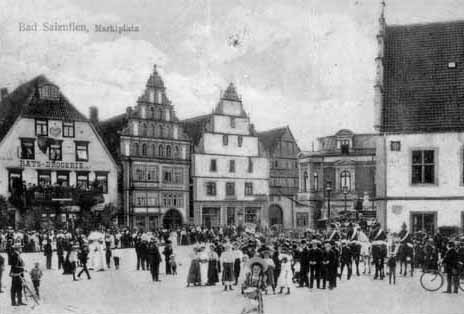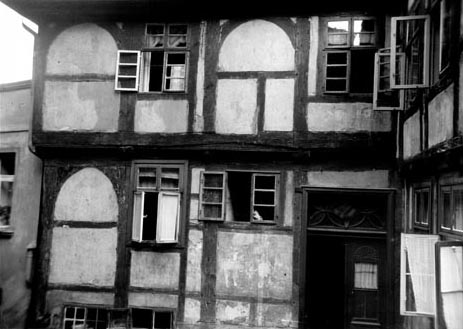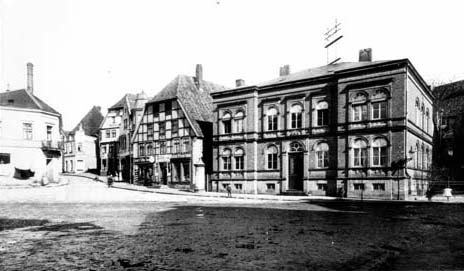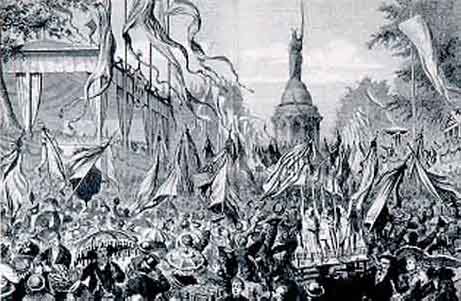History of Arminius
Documentary mention of “Arminius Hotel”
It all began more than 220 years ago, in 1787, when the merchant’s son Cornelius Schröder opened an inn at Ritterstraße 2. The house itself was built in 1577. Over the decades, the “Gasthaus Schröder” was renamed “Gasthaus zu Schröders Erben” (1825) and “Hotel Grimm” (1939). The first documented mention of the “Arminius Hotel” dates back to 1889. From 1921 to 1988 the hotel was run by the Bonnermann family.Ritterstraße 6
The area around the Ritterstraße – between the market and the Hafermarkt – is one of the oldest settlement centers in the city. Residential buildings have been proven here since the 14th century. There was already a salt works at the beginning of the 11th century and certainly also houses for the people who lived at that time, but where their buildings stood can only be guessed at. The area around the Ritterstraße was a preferred building area because it was protected from flooding and offered firm ground in contrast to the sandy and swampy Salzetal.
This settlement soon developed into a “minor town” that did not yet have city rights, but in contrast to the village had its own administration – a magistrate with its own seal and its own jurisdiction. Although not much remained of this soft area after the destruction in the Soest feud in 1447, the reconstruction soon began with some particularly large and magnificent houses, such as on the plot of today’s Ritterstraße 6.
The building
The building is a two-story half-timbered building with 9 bundles and a cantilevered upper floor from the 1st half of the 16th century. According to the construction features, it could have been built in 1530/40, but the names of the residents have only been recorded since 1549.
Probably from the very beginning there was a 3-barrel deep room installation along the left eaves in the high ground floor floorboard. The rear part of the house is separated by a stone stove wall, behind which is the hall with a basement. Both the hall chimney and the hall chimney were restored during the conversion to the hotel.
The rear gable triangle was probably always boarded up, nothing is known about the appearance of the front triangle, as it was removed around 1700 and replaced by a simple hip. Around the same time, the house underwent major changes in its internal structure and a two-storey extension was added. Because of the changed living needs, more space was now needed and thus a number of new windows for exposure.
Although the gable of the house faces the street, it was probably accessed from the eaves from the start, as the gable is on a high base due to the sloping terrain. In addition, this type of development is more appropriate for the court of a resident nobleman.
Around 1900 shoemaker Vandieken built a workshop in front of the front gable. This disfiguring addition was removed when the building was remodeled for Hotel Arminius purposes.
Ritterstraße 2
(BARHERMANN)
The building complex dates from the second half of the 16th century and was built by Nickell Wulfert. Although two dates have been preserved – 1577 is written both on the facade and in the sulfur beam in the left eaves – it is uncertain whether they indicate the year of construction or a redesign of the facade, because the rest of the inscriptions are either not preserved or incomprehensible.
The building consists of a front building and a slightly smaller rear building, which was built at the same time and is slightly offset to the side. Both structures have stone substructures and attached half-timbered storage floors that are completely separate from each other.
The front building was a high plank house, accessed through a large gate with a dentil profile, lit by a four-panel window above and a five-panel window to the left. The kitchen area at the back of the hallway was lit by a group of windows in the back gable. In the rear building there was a hall with a basement and large windows on all three outer walls. The storage floor was also designed as a hall and served as a special bedroom. The remaining door was either access to a hanging lavatory placed in front of the facade or an exit to the outside. This used to be possible because the ground level at the back was much higher than at the front of the house.
During a conversion around 1600, a two-storey floorboard was added to the side of the entrance gate in the front building and the large window overlooking the Utlucht was redesigned with a pent roof. Of these, only the side parts with two masks are original. The coats of arms of Lippe and Salzuflen, together with a family crest, were only added around 1700, perhaps by a member of the Vineator family who owned the property at the time, one of the wealthiest families in the city. At the same time as the conversion of the Auslucht, the half-timbered front of the storage floor was solidly bricked up with the two groups of windows under a double dentil frieze that have survived to this day. The gable triangle was probably reshaped into an equally magnificent stone stepped gable, as can still be seen on the mayor’s houses on the market today.
Another conversion around 1800 changed the former hallway into a multi-storey residential building, the rooms of which were accessible from a central longitudinal corridor. The gable triangle was provided with a crippled hip.
Around 1900, the ground floor area was rebuilt again for restaurant purposes.
While the core of the rear building has been hardly changed, much of the original substance has been destroyed in the front building. The carvings from the time of construction on the left eaves and the contrasting colored window frames are well preserved and restored true to the original.
The building was always a house for high demands. Mayor Johann zu Volckhausen lived here from 1595-1610, later the rich Vineator family. In 1736, the merchant Schröder, who came from Amsterdam, acquired the house, and his son Cornelius probably opened an inn with an adjoining dance hall for the first time in 1787. In 1801, an additional hall and bowling alley were set up and the adjoining building at Ritterstraße 4 was purchased. It served the Schröder family as a warehouse. This building has since been demolished and replaced by a new building with a Renaissance look. The last descendant of the Schröder family bequeathed the inn to the city. Now it was called “Gaststätte bei Schröder’s heirs”, the first tenant was Christian Dietrich Grimme in 1837. From 1842 he ran the first chocolate factory in Lippe together with the pharmacist Brandes. The name “Arminius-Hotel” first appeared in 1891 and goes back to the tenant at the time, the Detmold beer publisher Wilhelm Schäfer.
Who was Arminius?
Arminius was probably born in 17 BC. Born as the son of the Cheruscan prince Segimer. Like his brother Flavus, he took advantage of the opportunity offered by the then Roman emperor Tiberius (42 BC to 37 AD) to join the Roman army in order to be trained as a military leader and later to hold high office. In this way, the Romans hoped to tie the occupied territories more firmly to themselves and avoid riots among the people. Arminius also took advantage of this opportunity and learned the trade of war. For his services he was granted Roman citizenship and the honor of knighthood.
Arminius became famous through the battle in the Teutoburg Forest in 9 AD, in which the Roman legions under Varus were defeated, as is well known.
When Arminius returned to his homeland in AD 7, he found his people oppressed by the Roman governor Publius Quinctilius Varus (46 BC to AD 9). He had introduced the Roman court and tax system too quickly. He did not consider that the levying of taxes in Germania was hardly known at that time and was therefore felt to be unjust. Arminius was therefore able to persuade the quarreling Germanic tribes to unite against the foreign rule of the Romans and to put their disputes on hold.
“Varus, Varus, give me back my legions!”
In September of the year 9 AD, the Roman troops moved back from the Weser to their winter camp in Aliso on the Lippe (today’s Haltern in Westphalia). Arminius had put “reliable” scouts with local knowledge at the disposal of General Varus for this route through impassable terrain. They led an army of 3 legions (each about 4000-5000 soldiers plus a cavalry of 300 horsemen), additional cavalry and the entire entourage through a completely confusing, swampy forest area.
A total of around 25,000 men were on the move with equipment and provisions. The army, trimmed for order and discipline, was very vulnerable in this situation and also did not know the local conditions, whereas the Germans, with their local knowledge and a flexible way of fighting in the familiar area, made full use of their trump cards.
The entire Roman army was destroyed. Only part of the cavalry reached Aliso Castle. Allegedly, it could never be proved, Varus committed suicide during the battle, as did many of his officers. The legionary eagles carried by the Romans as a standard were captured by the Germans as trophies. The Roman emperor is said to have shouted after this battle:
“Varus, Varus, give me back my legions!”
After the battle, the Romans retreated to the Rhine, but invaded Germania again under Germanicus in AD 15 and defeated Arminius a year later. Germanicus was ordered back to Rome and Arminius managed to get the Romans to withdraw again. Since then, the Romans have not tried to conquer Germania.




